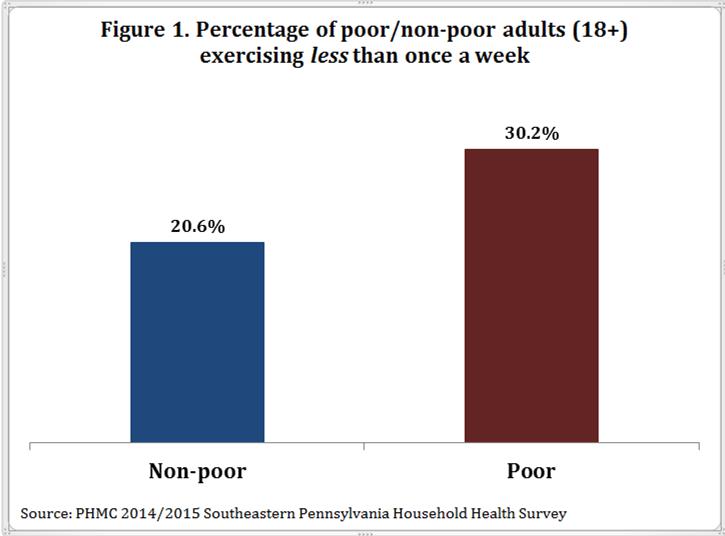NEWS RELEASE
FOR IMMEDIATE RELEASE
May 14, 2015
Contact: Veronica Mikitka Reed
vmikitka@mavenagency.com
215.434.7194
PHILADELPHIA—Thirty percent of people below the poverty line in Southeastern Pennsylvania are exercising less than once a week, according to survey data released today from the 2014-2015 Southeastern Pennsylvania Household Health Survey, a biennial survey conducted by Public Health Management Corporation's (PHMC's) Community Health Data Base.
In recognition of National Physical Fitness and Sports Month, CHDB is shining a light on how physical fitness contributes to better health and showcasing the barriers that impact individuals' abilities to take part in outdoor physical activities.
Below are data and information that illustrate two key barriers that hinder physical activity in the Southeastern Pennsylvania region:
Socio-Economic Status
Socio-economic status appears to be correlated in no small way with the amount of physical activity individuals were engaged in on a regular basis. A clear disparity exists between the poor and non-poor, defined by those below and above the federal poverty threshold.
The survey results indicate that 30.2 percent of those below the poverty line are exercising less than once a week. This is in stark contrast to the exercise regimens of those above the poverty line, where only 20.6 percent of individuals are exercising, on average, less than once a week.

While every individual is different, and each has his or her own reason(s) for not exercising, there are always externalities that have, on a macro level, a clear impact on such patterns.
Nearby Parks and Outdoor Space/ Environmental Barriers
Engaging in activities is largely contingent upon actually having a place to comfortably do so. One could assume that an individual would be far less likely to go for a walk or spend time in a community garden if there were no accessible outdoor spaces in his/her neighborhood, or, for that matter none which he/she felt comfortable visiting.
The survey results demonstrate that among those who have a park or outdoor space in their neighborhood that they are comfortable visiting, 54.5 percent exercise three or more times per week, and only 18.8 percent exercise less than once a week. This is significant when compared to those who do not have a park or outdoor space in their neighborhood that they are comfortable visiting; only 41.2 percent of these individuals reported exercising three or more times a week, while an alarming 31.6 percent reported exercising less than once a week.

The Household Health Survey is conducted by telephone and includes 10,000 households in the SEPA region (Bucks, Chester, Delaware, Montgomery and Philadelphia counties). For more information about these findings, contact Kyle B. Loder at 215.985.2525 or kloder@phmc.org.
About Public Health Management Corporation's Community Health Data Base
Public Health Management Corporation (PHMC) is a nonprofit public health institute that creates and sustains healthier communities. The Community Health Data Base (CHDB) includes the Household Health Survey, one of the largest regional health surveys in the country. The Pew Charitable Trusts, United Way of Southeastern Pennsylvania, United Way of North Penn, Green Tree Community Health Foundation, North Penn Community Health Foundation, Thomas Scattergood Foundation, Pottstown Area Health and Wellness Foundation, and more than 350 local agencies from the health, government, nonprofit and academic sectors help to support the CHDB and the survey. For more information, visit www.phmc.org.
###